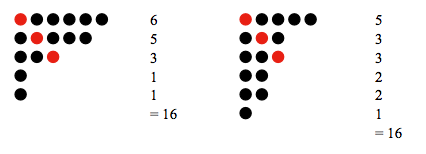Introduction to partitioning of integers(Part 1)

As this is my first note for the Torque Group any feed back from the staff and also my fellow users is welcome.
Let be a positive integer.In how many ways can one write a sum of (at least two) positive integers that add up to n?Consider the same set of integers written in different order to be different.
Consider the spaces between 1's in the following arrangement : 1_1_1_1........_1
In each of the spaces either we put "+" or we put ")+(".The number of ways to do it is .It is to be noted that each of these arrangements correspond to a unique way of partitioning n.This happens because by order of operations we need to add the numbers between each pair of parentheses first.
For example, for ,
Among the different possible combination the only one that does not correspond to a legal sum is = .
So the total number of possible ways is
A much more interesting idea is the number of ways in which one can write a sum of integers that add up to n, if different orders of summands are not distinguished.In this series of post I will try to provide a overview of this topic while introducing a few techniques for dealing with them.This will hopefully shed some light on the beauty of the subject for you.
A partition of an integer n , is one way of writing n as a sum of positive integers where order of the addends(terms to be added) does not matter.For the integer the function giving the number of partitions is denoted by .
As shown below there are 7 partitions of 5.Thus .
A Ferrer's diagram is a way of visualizing partitions with dots.Each row represents one addend in a partition.For example ,The partition of into and into is shown in the given diagram.
Here are a few problems that can be solved using Ferrer's diagrams please post your solutions in the comments.
. Show that the number of partitions of an integer into parts the largest of which is is equal to the number of partitions of into exactly r parts.
. Prove that every number of the form where is an integer greater than one and is a positive integer can be represented as the sum of positive odd integers.
. Prove that the number of partitions of with no part greater than is equal to the number of partitions of with exactly parts
In the next post I will introduce generating functions in association to solving partition problems and in another post I will discuss stacking problems.Good Day!!
Click here for part 2
Easy Math Editor
This discussion board is a place to discuss our Daily Challenges and the math and science related to those challenges. Explanations are more than just a solution — they should explain the steps and thinking strategies that you used to obtain the solution. Comments should further the discussion of math and science.
When posting on Brilliant:
*italics*or_italics_**bold**or__bold__paragraph 1
paragraph 2
[example link](https://brilliant.org)> This is a quote# I indented these lines # 4 spaces, and now they show # up as a code block. print "hello world"\(...\)or\[...\]to ensure proper formatting.2 \times 32^{34}a_{i-1}\frac{2}{3}\sqrt{2}\sum_{i=1}^3\sin \theta\boxed{123}Comments
Can anyone tell me how to place a picture in a definite spot in the post and also attaching multiple images...Thanks in advance....
I don't even know how to attach a picture. My computer doesn't let me click on the link to attach a picture. :/
Log in to reply
@Finn Hulse do
Notice the exclaimation mark. REMEMBER NO SPACES.
So... How do I figure out how many ways I can add numbers to get a number? You never said a formula.
Log in to reply
In this post I have defined the pictorial representation only ..the main formula will be using generating functions in my next post,,,the pictorial representation itself cab be used to prove a few properties...Here is part 2
What do u mean in Problem 1?
Log in to reply
Prove that the number of ways to partition a number n such that the largest partition of it has value r is the same as the number of partitions of n into r partitions. Does that make any more sense?
Log in to reply
yes! Thanks Daniel L. :)
I think the problem is judt as it says....try on a smaller example to get a better idea
Can anyone explain why (1+1+...+1)=n is not a legal sum ?
Log in to reply
In the question we are required to find the no of sums of at least 2 two positive integers that add up to n... (1+1+1+1....+1) corresponds to the sum n+0 and 0 is not positive...
I am not even sure what I am writing is even sane, but I think the answer to problem lies in the fact that nC(n-r) is equal to nCr(where aCb = a!/((a-b)!.b!)). Also (1+1)^n=1+n....n+1. As the largest number possible is r therefore there are exactly (n/r)-1 minimum number of spaces between the additions(where (n/r) is the closest larger integer if n/r isn't an integer and denotes simple bracket if it an integer). Therefore, by simple combinatorics and using my first statement I think both are equal(2 to power((n/r)-1)-1. I would request you to make sense of my answer if you can,for I am not as good as you are in explaining things to others and must confess that I have an intuitive idea of Problem 1 at best. If I am wrong altogether, then please write the correct solution so that I can understand how it works